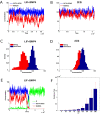Probing the role of stochasticity in a model of the embryonic stem cell: heterogeneous gene expression and reprogramming efficiency
- PMID: 22889237
- PMCID: PMC3468383
- DOI: 10.1186/1752-0509-6-98
Probing the role of stochasticity in a model of the embryonic stem cell: heterogeneous gene expression and reprogramming efficiency
Abstract
Background: Embryonic stem cells (ESC) have the capacity to self-renew and remain pluripotent, while continuously providing a source of a variety of differentiated cell types. Understanding what governs these properties at the molecular level is crucial for stem cell biology and its application to regenerative medicine. Of particular relevance is to elucidate those molecular interactions which govern the reprogramming of somatic cells into ESC. A computational approach can be used as a framework to explore the dynamics of a simplified network of the ESC with the aim to understand how stem cells differentiate and also how they can be reprogrammed from somatic cells.
Results: We propose a computational model of the embryonic stem cell network, in which a core set of transcription factors (TFs) interact with each other and are induced by external factors. A stochastic treatment of the network dynamics suggests that NANOG heterogeneity is the deciding factor for the stem cell fate. In particular, our results show that the decision of staying in the ground state or commitment to a differentiated state is fundamentally stochastic, and can be modulated by the addition of external factors (2i/3i media), which have the effect of reducing fluctuations in NANOG expression. Our model also hosts reprogramming of a committed cell into an ESC by over-expressing OCT4. In this context, we recapitulate the important experimental result that reprogramming efficiency peaks when OCT4 is over-expressed within a specific range of values.
Conclusions: We have demonstrated how a stochastic computational model based upon a simplified network of TFs in ESCs can elucidate several key observed dynamical features. It accounts for (i) the observed heterogeneity of key regulators, (ii) characterizes the ESC under certain external stimuli conditions and (iii) describes the occurrence of transitions from the ESC to the differentiated state. Furthermore, the model (iv) provides a framework for reprogramming from somatic cells and conveys an understanding of reprogramming efficiency as a function of OCT4 over-expression.
Figures




Similar articles
-
β-catenin fluctuates in mouse ESCs and is essential for Nanog-mediated reprogramming of somatic cells to pluripotency.Cell Rep. 2014 Sep 25;8(6):1686-1696. doi: 10.1016/j.celrep.2014.08.011. Epub 2014 Sep 4. Cell Rep. 2014. PMID: 25199832
-
Trib2 regulates the pluripotency of embryonic stem cells and enhances reprogramming efficiency.Exp Mol Med. 2017 Nov 24;49(11):e401. doi: 10.1038/emm.2017.191. Exp Mol Med. 2017. PMID: 29170476 Free PMC article.
-
A computational model for understanding stem cell, trophectoderm and endoderm lineage determination.PLoS One. 2008;3(10):e3478. doi: 10.1371/journal.pone.0003478. Epub 2008 Oct 22. PLoS One. 2008. PMID: 18941526 Free PMC article.
-
Cell cycle and pluripotency: Convergence on octamer‑binding transcription factor 4 (Review).Mol Med Rep. 2017 Nov;16(5):6459-6466. doi: 10.3892/mmr.2017.7489. Epub 2017 Sep 13. Mol Med Rep. 2017. PMID: 28901500 Free PMC article. Review.
-
Role of Oct4 in maintaining and regaining stem cell pluripotency.Stem Cell Res Ther. 2010 Dec 14;1(5):39. doi: 10.1186/scrt39. Stem Cell Res Ther. 2010. PMID: 21156086 Free PMC article. Review.
Cited by
-
A stochastic and dynamical view of pluripotency in mouse embryonic stem cells.PLoS Comput Biol. 2018 Feb 16;14(2):e1006000. doi: 10.1371/journal.pcbi.1006000. eCollection 2018 Feb. PLoS Comput Biol. 2018. PMID: 29451874 Free PMC article.
-
An extended model for culture-dependent heterogenous gene expression and proliferation dynamics in mouse embryonic stem cells.NPJ Syst Biol Appl. 2017 Aug 3;3:19. doi: 10.1038/s41540-017-0020-5. eCollection 2017. NPJ Syst Biol Appl. 2017. PMID: 28794899 Free PMC article.
-
Approximate Bayesian computation for inferring Waddington landscapes from single-cell data.R Soc Open Sci. 2024 Jul 10;11(7):231697. doi: 10.1098/rsos.231697. eCollection 2024 Jul. R Soc Open Sci. 2024. PMID: 39076359 Free PMC article.
-
Cell cycle expression heterogeneity predicts degree of differentiation.bioRxiv [Preprint]. 2024 Jul 22:2024.07.19.604184. doi: 10.1101/2024.07.19.604184. bioRxiv. 2024. Update in: Brief Bioinform. 2024 Sep 23;25(6):bbae536. doi: 10.1093/bib/bbae536. PMID: 39091773 Free PMC article. Updated. Preprint.
-
Network Features and Dynamical Landscape of Naive and Primed Pluripotency.Biophys J. 2018 Jan 9;114(1):237-248. doi: 10.1016/j.bpj.2017.10.033. Biophys J. 2018. PMID: 29320691 Free PMC article.
References
Publication types
MeSH terms
Substances
LinkOut - more resources
Full Text Sources
Research Materials

